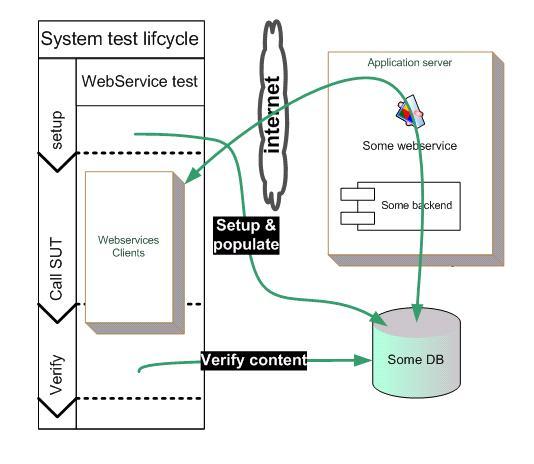SoapUI
Installation
If you are using maven, you can add following dependency to your project.
01 02 03 04 05 06 07 08 09 10 11 | <dependency> <groupId>org.unitils.soapui</groupId> <artifactId>unitils-soapui</artifactId> <version>1.0.2</version> <exclusions> <exclusion> <groupId>javafx</groupId> <artifactId>jfxrt</artifactId> </exclusion> </exclusions></dependency> |
Config
Please create unitils-local.properties, and add mail to unitils.modules. Code as following:
01 02 03 04 05 06 07 08 09 10 | unitils.modules = ...., soapui, ...unitils.module.soapui.className = org.unitils.soapui.WebserviceModule unitils.module.soapui.runAfter= unitils.module.soapui.enabled=trueorg.unitils.soapui.default.project.file = ??? org.unitils.soapui.default.project.suite = ??? org.unitils.soapui.default.project.endpoint = ??? org.unitils.soapui.default.cleanup = ??? |
How does it work

- setup: In the setup phase we set our SUT and the systems it uses in a known state. We prepare them to be used afterwards. One of the most common things are database setup and loading data in database.
- In this phase we will use our client / tool to create and post a request to the webservice.
- After calling the webservice we could do some assertions on the response but we could also check other things of our SUT, like the state of the database. This is done in the verification phase.
Combining Unitils, SoapUI and jUnit
01 02 03 04 05 06 07 08 09 10 11 | @RunWith(UnitilsJUnit4TestClassRunner.class)public class SimplePlatformIntegrationConsumerTest { @WebserviceTestSoapUi(testCase = "checkAccessControl TestCase") private WebserviceTest ws; @Test public void checkAccessControl() { ws.triggerTestCase(); }} |
First we define a WebserviceTest property which will hold the configuration of the soapui testcases we want to run. This property we have to annotate with @WebserviceTestSoapUi which has four values that you can set.
| testCase | The soapUi name of the testcase that you want to run. This has no default value. |
| suite | The soapUi name of the suite where the testcase resides. If no value is specified the one you defined in the property file will be taken. |
| endpoint | The location for accessing the webservice. If no value is specified the one you defined in the property file will be taken. |
| projectFile | The location of the soapUI project file. If no value is specified the one you defined in the property file will be taken. This is a file where SoapUI saves your soap project/testcases/testsuites. |
If you want to run a lot of testcases in your testclass, than you will have to define a lot of WebserviceTest.
01 02 03 04 05 06 07 08 09 10 11 12 13 14 15 16 17 18 19 20 21 22 23 24 | @WebserviceTestSoapUi(testCase = "checkAccessControl1 TestCase")private WebserviceTest ws1;@WebserviceTestSoapUi(testCase = "checkAccessControl2 TestCase")private WebserviceTest ws2;@WebserviceTestSoapUi(testCase = "checkAccessControl3 TestCase")private WebserviceTest ws3;//.... etc.@Test public void checkAccessControl1() { ws1.triggerTestCase();}@Test public void checkAccessControl2() { ws2.triggerTestCase();}@Test public void checkAccessControl3() { ws3.triggerTestCase();} |
Although this approach works you'll remark a performance drawback. For every test all WebserviceTest are recreated and this is a time consuming process.
To solve this problem you can use the @WebserviceTestPlaceHolder on the WebserviceTest and put your WebserviceTestSoapUi configuration on the testmethod itself. This way only the webservicetest you need for the test you want to run is configured, not the other ones.
01 02 03 04 05 06 07 08 09 10 11 12 13 14 15 16 17 18 19 20 | @WebserviceTestPlaceHolderprivate WebserviceTest ws;//....@Test @WebserviceTestSoapUi(testCase = "checkAccessControl1 TestCase") public void checkAccessControl1() { ws.triggerTestCase();}@Test@WebserviceTestSoapUi(testCase = "checkAccessControl2 TestCase") public void checkAccessControl2() { ws.triggerTestCase();}@Test @WebserviceTestSoapUi(testCase = "checkAccessControl3 TestCase")public void checkAccessControl3() { ws.triggerTestCase();} |
Multiple endpoints
Often you want to run the same test, or another test, against different endpoints on the same host.
This is done by stripping the last part of the endpoint (org.unitils.soapui.default.project.endpoint) and adding it in the WebserviceTestSoapUi annotation.
This will allow you to test different versions or multiple endpoints on the same server.
01 02 03 04 05 06 07 08 09 10 11 12 13 14 | @WebserviceTestPlaceHolderprivate WebserviceTest ws;@Test@WebserviceTestSoapUi(testCase = "checkAccessControl TestCase", endPointPostfix = "v1")public void checkAccessControlOtherEndpointV1() { ws.triggerTestCase();}@Test@WebserviceTestSoapUi(testCase = "checkAccessControl TestCase", endPointPostfix = "v2")public void checkAccessControlOtherEndpointV2() { ws.triggerTestCase();} |